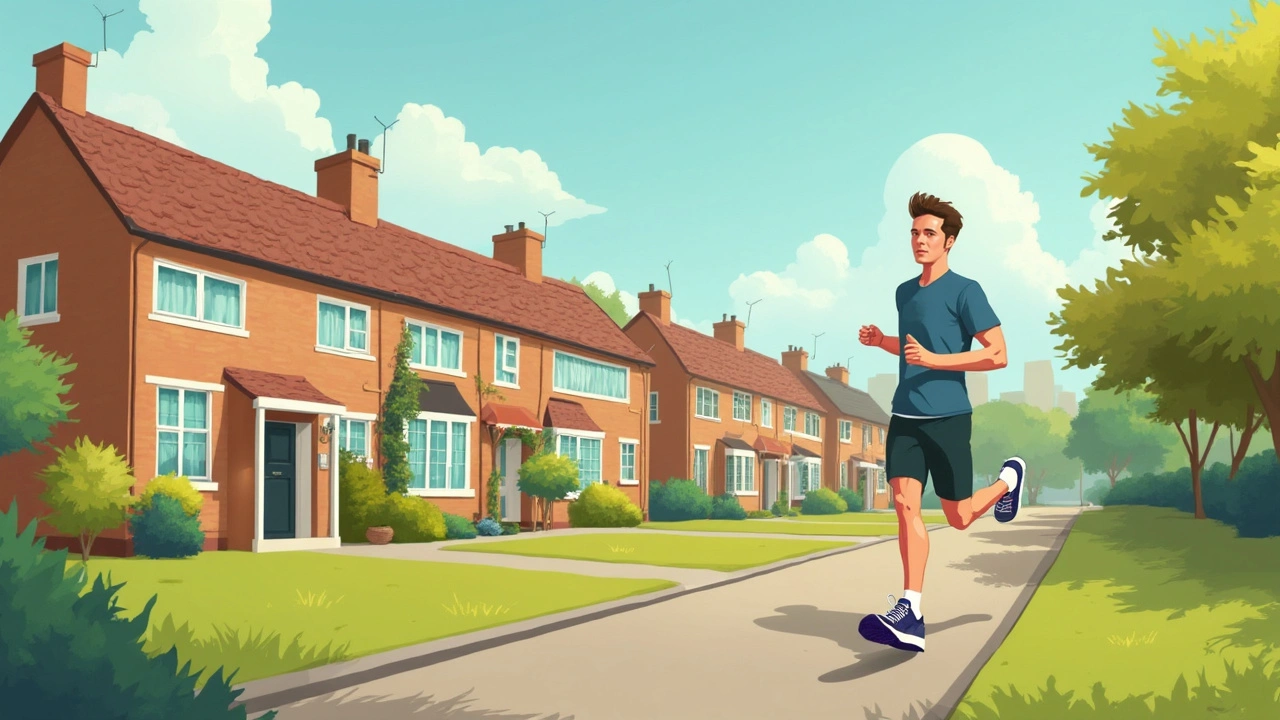Ever had a spot in your neck or back that feels like a rock, even when you’re just sitting still? That’s a trigger point, or what most people call a muscle knot. These little troublemakers can pull on your muscles, mess with your posture, and sometimes shoot pain somewhere totally unexpected—like a knot in your shoulder causing headaches or tingling down your arm.
Trigger point massage gets right to the source. Instead of long, slow strokes, the focus is on pushing right into those knots. The goal isn’t just to make you feel good for five minutes. It’s about helping that tight spot finally chill out so the rest of your muscles can work like they’re supposed to. People usually notice real pain relief and better movement after a session, even if it can be kind of intense in the moment.
- What are Trigger Points (Muscle Knots)?
- How Trigger Point Massage Differs from Regular Massage
- Finding and Releasing Trigger Points: What to Expect
- DIY Trigger Point Massage Tips
- Common Myths and What Science Really Says
What are Trigger Points (Muscle Knots)?
A trigger point is like a tiny, super tight spot inside your muscle that just refuses to let go. When you find one, it can feel sore or even send weird pain to places you’d never expect. These muscle knots form when muscle fibers get stuck in a contracted position, usually from stress, bad posture, overuse, or even just sleeping funny.
If you've ever pressed on a sore spot and felt pain shoot somewhere else, that’s a classic sign you’ve hit a trigger point. They show up most often in places like your neck, shoulders, upper back, and hips—anywhere that deals with a lot of tension day after day.
Researchers have mapped out common spots where trigger points show up, known as "trigger point maps." For example, that annoying knot at the top of your shoulder (the trapezius muscle) is notorious, and it's often the one that people try to rub out at their desks.
These knots aren’t dangerous, but they can make your muscles weak or stiff and limit how much you can move. They can also mess with your posture over time. If you ignore them, your body will try to work around them, which can just lead to new aches in other places. That’s why trigger point massage has become popular—it actually targets the root of the problem.
You don’t have to be a pro athlete or gym rat to get trigger points. Anyone who sits at a laptop a lot, stands all day, or even just deals with everyday stress can get them. Knowing what they are is the first step toward finally feeling some relief.
How Trigger Point Massage Differs from Regular Massage
If you’ve ever gotten a Swedish or deep tissue massage, you probably remember the slow, sweeping moves over big muscle groups. Those styles aim to relax you, boost blood flow, and sort out day-to-day muscle tightness. But trigger point massage skips the full-body approach and gets laser-focused on one thing: active knots that cause pain, stiffness, or even weird symptoms like headaches or numbness.
Here’s what really sets them apart:
- Precision over broad strokes: Instead of working an entire muscle, the therapist hunts down specific sore spots—sometimes as small as a blueberry—and tackles them directly.
- Pressure technique: In trigger point massage, steady pressure is held on the knot until it starts to release. This can feel uncomfortable (some say it’s a “good pain”) but shouldn’t have you gritting your teeth. Swedish and relaxation massages rarely use this kind of direct, pinpoint pressure.
- Targeted pain relief: Regular massage helps with overall stress and tightness, but trigger point sessions are designed to break up knots that keep coming back.
- Session focus: A single trigger point session might only work on one or two areas, not your full body. That’s because this method zeroes in on what’s actually causing the pain.
- Results: People often feel immediate, noticeable relief after a trigger point session—especially if their pain comes from a stubborn knot. Regular massage is relaxing but isn’t as likely to untangle those tough spots.
If you like seeing numbers, here’s a quick breakdown showing key differences:
| Type | What It Targets | Main Techniques | Session Length | Common Goal |
|---|---|---|---|---|
| Regular (Swedish/Relaxation) | Whole body, general muscle groups | Long strokes, kneading, light pressure | 60-90 minutes | Relaxation, general tension relief |
| Trigger Point Massage | Specific knots (trigger points) | Sustained, focused pressure right on the knot | 15-60 minutes (often shorter) | Relief of targeted pain, release muscle knots |
Good to know: Trigger point work can be added to any massage session. Just let your therapist know you want to tackle stubborn knots—because sometimes a regular back rub just won’t cut it.

Finding and Releasing Trigger Points: What to Expect
So how do you even spot a trigger point? It isn’t rocket science, but you do need to pay attention. Trigger points usually feel like a hard lump or a little bump under your skin, sometimes about the size of a pea or even smaller. They’re often sore if you press on them, and that soreness might spread further—like you press a spot on your shoulder, and suddenly your neck or head starts hurting. That’s classic referred pain, the sneaky culprit behind many random aches.
During a trigger point massage, the therapist will look for these tight spots by using their fingers, thumbs, or even an elbow. Sometimes they’ll ask you to move your arm or leg to help zero in on the right spot. It’s not always comfortable; sometimes it feels like a dull ache, maybe a sharp sting, or even a twitch when they hit the right spot. But a good therapist checks in, because the pain should be intense-but-tolerable, never outright torture.
What happens next? The therapist holds pressure there (usually 30 seconds to a minute). You might notice a weird wave of relief or even a warm feeling around the area. That’s your muscle starting to relax and the trigger point letting go. If you’re new to this, don’t be surprised if you feel sore for a day or two after, sort of like you overdid it at the gym. That’s totally normal.
- Start with light pressure and build up slowly.
- Breathe deep and try to relax the rest of your body—the more tense you are, the less effective the release.
- Stay hydrated before and after; relaxed muscles move fluid better and flush out waste products.
- If a spot won’t loosen up after a minute or gets more painful, leave it alone and try another day.
For folks who want numbers: Some physical therapy studies measure pressure-pain thresholds after trigger point work and usually see about a 25-30% drop in soreness after just one session. Here’s a quick look at what people usually report during and after trigger point massage:
| What You Might Feel | When It Happens |
|---|---|
| Mild ache/tenderness | During pressure |
| Twitch or jump response | When the knot is hit just right |
| Warmth/spreading sensation | As it starts to release |
| Soreness (like post-workout) | Few hours to 2 days after |
| Better movement, less pain | Usually within a day or two |
If you’re going solo and trying to find knots on yourself, a tennis ball or foam roller can be your best friend. Just roll it slowly over the sore area until you hit a hot spot, then hold there and breathe. Take breaks—your muscles will thank you later.
DIY Trigger Point Massage Tips
You don’t need a fancy setup or a license to get started with trigger point massage at home. If you’ve got a tennis ball, a foam roller, or even just your hands, you’re set. The trick is knowing where and how to press so you’re not just poking around without results.
First up, here’s how you spot those stubborn knots: press around muscle areas that hurt or feel tight. A trigger point will usually feel more solid and tender compared to the rest of the muscle. Common spots? Upper shoulders, between the shoulder blades, lower back, and hips. Don’t be surprised if pressing one spot makes pain show up somewhere else—trigger points like to send pain to other areas.
- Start slow: Use gentle pressure at first and ramp up until you feel that dull, achy sensation (not sharp pain).
- Hold it: Keep pressure on the knot for about 30-60 seconds. The spot might feel like it’s releasing—almost like the muscle is melting a bit.
- Roll or move: For bigger areas, try rolling a ball or foam roller slowly back and forth. For smaller knots, your fingers or thumb should do the trick.
- Stay relaxed: Try to keep the rest of your body loose while you work on a knot. If you tense up, it just fights the process.
- Don’t overdo it: Two or three minutes per tight spot, once or twice a day, is enough for most people. Too much can cause soreness.
A lot of people feel improvement after just a week of hitting their trouble spots for a few minutes each day. But if a knot sticks around for months or gets worse, it’s worth talking to a professional or checking with your doctor.
Here's a quick reference table for DIY tools with their pros and best use areas:
| Tool | Best For | How to Use |
|---|---|---|
| Tennis ball/lacrosse ball | Shoulders, back, glutes, feet | Lean against wall or floor, roll slowly |
| Foam roller | Quads, hamstrings, IT band, upper back | Place roller under area and roll back and forth |
| Thumbs/fingers | Neck, small trigger points | Press directly, hold steady pressure |
| Massage stick | Calves, thighs, forearms | Roll stick with both hands along muscle |
Don’t forget: Stay hydrated and move around after each session. Muscles release waste products when they relax, so water and light stretches help flush things out. And if something feels wrong or makes your pain worse, it’s time to pause and get pro advice.

Common Myths and What Science Really Says
There’s a lot of hype around trigger point massage, and let’s be honest, more than a few myths floating around. It’s easy to get mixed up with what actually works and what’s just wishful thinking. Here’s how the facts stack up.
- Trigger point massage doesn’t “break up” muscle knots like smashing a rock. Muscles don’t work that way. What’s really happening? The focused pressure can help calm down irritated nerves and improve blood flow to the area, making the knot soften up.
- Some people believe trigger points cause all pain. That’s a stretch. They’re one part of the puzzle. Things like overuse, stress, or poor posture can create or worsen trigger points, but not every ache in your body is from a knot.
- There’s a rumor that it should hurt—a lot—to work. The truth? Some discomfort is normal, but if you’re gritting your teeth, that’s a red flag. Science supports the idea that moderate, not extreme, pressure helps release knots.
- Another popular story says you only need one massage to fix a problem for good. Research says otherwise. Studies (including a 2021 clinical review from the Journal of Bodywork and Movement Therapies) show it usually takes a few sessions, combined with stretches and moving more during the day, for results to really last.
Here’s a quick look at what the research highlights about results and expectations:
| Myth | What Research Shows |
|---|---|
| Muscle knots are lumps of scar tissue | They're spots where muscle fibers stay tight—no scar tissue involved |
| You need deep pain for real change | Moderate, comfortable pressure works as well, and sometimes better |
| One session fixes everything | Most people need regular treatments and self-care for lasting results |
| Trigger points show up on X-rays or MRIs | Current scans can’t reliably spot them—feeling them by hand is still the best tool |
So, if someone promises instant magic or says ‘no pain, no gain’ is the only way, you’ve got every reason to be skeptical. Real relief comes from smart, steady work—not chasing myths.


 Health and Wellness
Health and Wellness